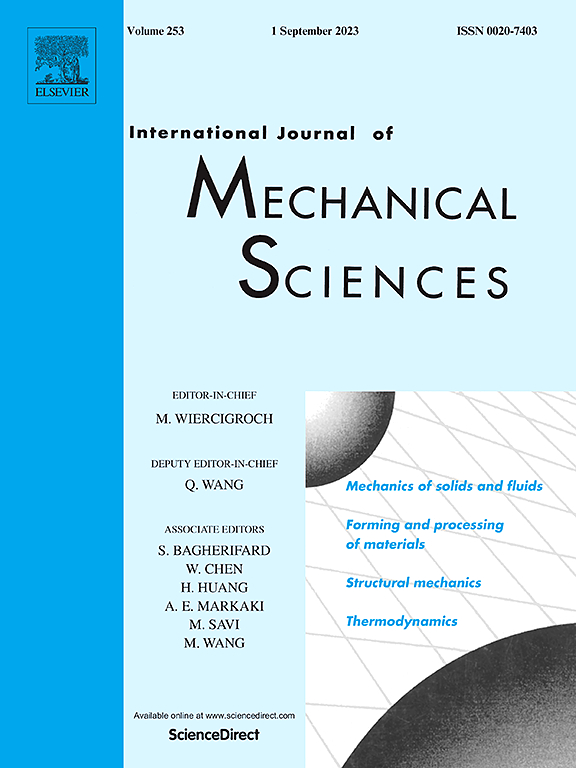具有空前可恢复性的功能梯度spinodal纳米结构陶瓷
IF 9.4
1区 工程技术
Q1 ENGINEERING, MECHANICAL
International Journal of Mechanical Sciences
Pub Date : 2025-06-25
DOI:10.1016/j.ijmecsci.2025.110453
引用次数: 0
摘要
轻质建筑材料面临的一个基本挑战是,由于层状屈曲、塑性剪切带或断裂,它们容易发生局部破坏。最近的研究已经利用失序来中断局部化和增强变形,但大多数设计策略只是分散损伤的积累,而不能阻止损伤的发展和传播。这项工作探讨了如何设计梯度结构来阻止纳米结构陶瓷超材料的裂纹扩展和促进可恢复性。我们通过实验和数值研究了5种不同的壳基spinodal陶瓷纳米结构,它们具有10-80 nm厚的氧化铝薄膜。这些材料是利用双光子光刻技术在牺牲聚合物支架上进行原子层沉积制备的。所有薄壁(40纳米)结构都经历了壳屈曲主导的变形,并在压缩至45%应变后显示出几乎完全的恢复,这是这类纳米结构材料的预期结果。厚壁(40 nm)各向同性和各向异性结构在压缩过程中经历了相当大的局部损伤,即使在低应变下也可以预见地表现出永久破坏。出乎意料的是,厚壁海螺壳启发的梯度结构显示局部损伤,但在压缩至45%应变后完全恢复。这种程度的可恢复性从未在高密度的纳米结构陶瓷中观察到,特别是在压缩过程中具有可见的局部开裂。这一结果源于结构非均质性的长度尺度——梯度层足够小,从而抑制了裂纹扩展所需的局部损伤发展,从而防止了灾难性破坏。我们的发现对于如何利用长度尺度和非均质性来设计脆性成分的抗破坏材料具有重要意义。本文章由计算机程序翻译,如有差异,请以英文原文为准。
Functionally graded spinodal nanoarchitected ceramics with unprecedented recoverability
A fundamental challenge for lightweight architected materials is their propensity for localized failure due to layered buckling, plastic shear-banding or fracture. Recent research efforts have used disorder to interrupt localization and enhance deformation, but most design strategies simply distribute the accumulation of damage, they do not prevent it from developing and propagating. This work explores how gradient architecture can be designed to hinder crack propagation and promote recoverability in nanostructured ceramic metamaterials. We experimentally and numerically investigated five different shell-based spinodal ceramic nanoarchitectures with 10-80 nm thick alumina films. These were fabricated using atomic layer deposition on sacrificial polymeric scaffolds written using two-photon lithography. All thin-walled (40 nm) architectures underwent shell buckling-dominated deformation and showed nearly full recovery after compression to 45% strain, an expected result for this class of nanoarchitected materials. Thick-walled (40 nm) isotropic and anisotropic architectures experienced considerable local damage during compression and predictably showed permanent failure even at low strains. Unexpectedly, thick-walled conch-shell inspired gradient architectures showed localized damage but experienced a full recovery after compression to 45% strain. This degree of recoverability has never been observed in this high density of a nanostructured ceramic, particularly one with visible local cracking during compression. This result stems from the length scale of the structural heterogeneity — the gradient layers were sufficiently small so as to inhibit the local damage development needed for crack propagation, thereby preventing catastrophic failure. Our findings have significant implications for how length scales and heterogeneity can be used to design failure-resistant materials from brittle constituents.
求助全文
通过发布文献求助,成功后即可免费获取论文全文。
去求助
来源期刊

International Journal of Mechanical Sciences
工程技术-工程:机械
CiteScore
12.80
自引率
17.80%
发文量
769
审稿时长
19 days
期刊介绍:
The International Journal of Mechanical Sciences (IJMS) serves as a global platform for the publication and dissemination of original research that contributes to a deeper scientific understanding of the fundamental disciplines within mechanical, civil, and material engineering.
The primary focus of IJMS is to showcase innovative and ground-breaking work that utilizes analytical and computational modeling techniques, such as Finite Element Method (FEM), Boundary Element Method (BEM), and mesh-free methods, among others. These modeling methods are applied to diverse fields including rigid-body mechanics (e.g., dynamics, vibration, stability), structural mechanics, metal forming, advanced materials (e.g., metals, composites, cellular, smart) behavior and applications, impact mechanics, strain localization, and other nonlinear effects (e.g., large deflections, plasticity, fracture).
Additionally, IJMS covers the realms of fluid mechanics (both external and internal flows), tribology, thermodynamics, and materials processing. These subjects collectively form the core of the journal's content.
In summary, IJMS provides a prestigious platform for researchers to present their original contributions, shedding light on analytical and computational modeling methods in various areas of mechanical engineering, as well as exploring the behavior and application of advanced materials, fluid mechanics, thermodynamics, and materials processing.
 求助内容:
求助内容: 应助结果提醒方式:
应助结果提醒方式:


